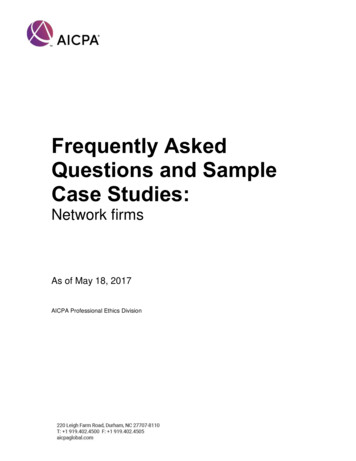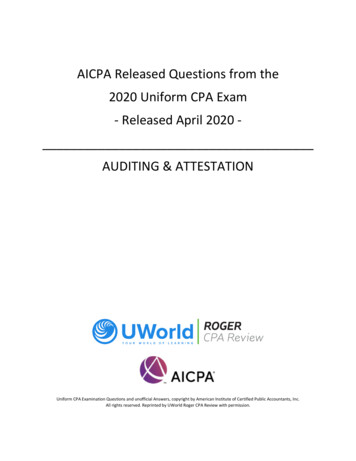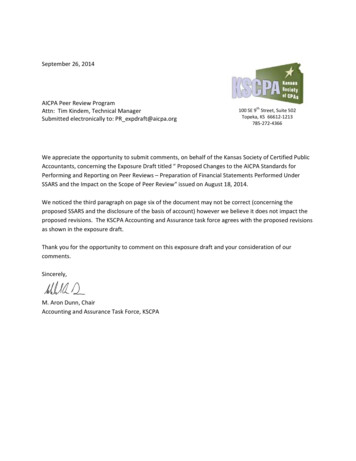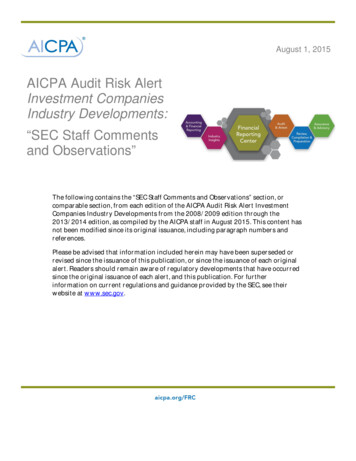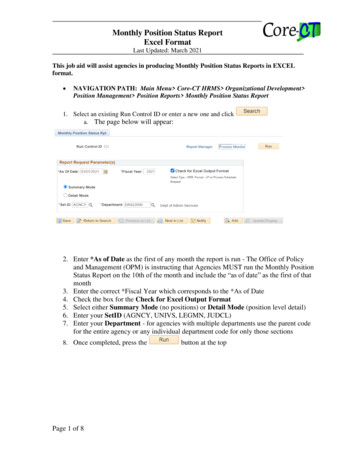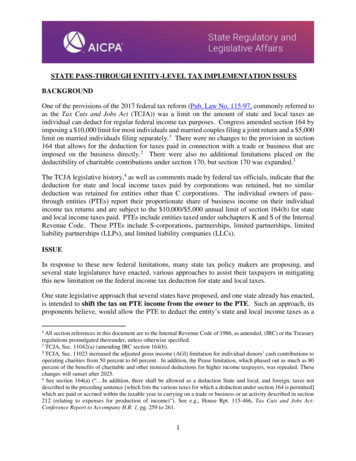
Transcription
STATE PASS-THROUGH ENTITY-LEVEL TAX IMPLEMENTATION ISSUESBACKGROUNDOne of the provisions of the 2017 federal tax reform (Pub. Law No. 115-97, commonly referred toas the Tax Cuts and Jobs Act (TCJA)) was a limit on the amount of state and local taxes anindividual can deduct for regular federal income tax purposes. Congress amended section 164 byimposing a 10,000 limit for most individuals and married couples filing a joint return and a 5,000limit on married individuals filing separately.1 There were no changes to the provision in section164 that allows for the deduction for taxes paid in connection with a trade or business that areimposed on the business directly.2 There were also no additional limitations placed on thedeductibility of charitable contributions under section 170, but section 170 was expanded.3The TCJA legislative history,4 as well as comments made by federal tax officials, indicate that thededuction for state and local income taxes paid by corporations was retained, but no similardeduction was retained for entities other than C corporations. The individual owners of passthrough entities (PTEs) report their proportionate share of business income on their individualincome tax returns and are subject to the 10,000/ 5,000 annual limit of section 164(b) for stateand local income taxes paid. PTEs include entities taxed under subchapters K and S of the InternalRevenue Code. These PTEs include S-corporations, partnerships, limited partnerships, limitedliability partnerships (LLPs), and limited liability companies (LLCs).ISSUEIn response to these new federal limitations, many state tax policy makers are proposing, andseveral state legislatures have enacted, various approaches to assist their taxpayers in mitigatingthis new limitation on the federal income tax deduction for state and local taxes.One state legislative approach that several states have proposed, and one state already has enacted,is intended to shift the tax on PTE income from the owner to the PTE. Such an approach, itsproponents believe, would allow the PTE to deduct the entity’s state and local income taxes as a1All section references in this document are to the Internal Revenue Code of 1986, as amended, (IRC) or the Treasuryregulations promulgated thereunder, unless otherwise specified.2TCJA, Sec. 11042(a) (amending IRC section 164(b).3TCJA, Sec. 11023 increased the adjusted gross income (AGI) limitation for individual donors’ cash contributions tooperating charities from 50 percent to 60 percent. In addition, the Pease limitation, which phased out as much as 80percent of the benefits of charitable and other itemized deductions for higher income taxpayers, was repealed. Thesechanges will sunset after 2025.4See section 164(a) (“ In addition, there shall be allowed as a deduction State and local, and foreign, taxes notdescribed in the preceding sentence [which lists the various taxes for which a deduction under section 164 is permitted]which are paid or accrued within the taxable year in carrying on a trade or business or an activity described in section212 (relating to expenses for production of income)”). See e.g., House Rpt. 115-466, Tax Cuts and Jobs Act:Conference Report to Accompany H.R. 1, pg. 259 to 261.1
tax on the business at the federal level, followed by a deduction for the PTE tax in the distributiveshare of the PTE owners’ income. These state proposals also would provide that the owner ispermitted to claim a credit on the owner’s state income tax return for the amount of the owner’sdistributive share of the taxes paid by the PTE.A PTE state-level tax was recently enacted in Connecticut, 5 and other states are considering similarproposals. As states consider enacting PTE-level taxes, states and state CPA societies shouldconsider various perspectives and implementation issues regarding this approach.The multitude of methodologies that states employ to impose tax on income and capital, thepotential lack of guidance from state authorities, and the variety of taxpayer-specific fact patternswill likely result in added compliance complexities. In addition, it is uncertain whether federal taxofficials will respect or challenge these approaches.IMPORTANCE TO CPAsGiven the number of PTEs and the novelty of the recently enacted federal limitations on thedeductibility of state and local taxes for PTE owners, we anticipate some states will considerenacting an entity-level tax with a corresponding credit to the PTE owners. PTE-level taxes willhave broad federal and state tax consequences. CPAs regularly assist PTEs and their owners withtax compliance and planning, and interact with state tax authorities on their behalf. In addition,many CPA firms are formed as PTEs.CPAs are interested in working with state tax authorities and legislatures as they consider possibleentity-level taxes on PTEs. Entity-level taxes have implications regarding both state tax revenuesand state taxpayers, including PTEs and individual taxpayers.RECENT STATE ACTIVITYOn May 31, 2018, the Governor of Connecticut signed into law Public Act 18-49 (Act) thatcontains a PTE-level tax. The Act imposes a 6.99% entity-level income tax on most PTEs inConnecticut. Owners of PTEs are entitled to a credit against their Connecticut personal income taxequal to 93.01% of the PTE owner’s pro rata share of the PTE-level tax paid by their PTE. Thestate law grants a Connecticut resident owner of a PTE with a credit for any entity-level taximposed by other states that the Connecticut Department of Revenue Services (CDRS) determinesis similar to the Connecticut PTE-level tax.The Act also provides that PTEs subject to the Connecticut PTE-level tax are required to makequarterly estimated tax payments. On June 6, 2018, the CDRS issued guidance regarding theConnecticut PTE-level tax and the estimated payment requirements thereunder.6 In addition,5See Entity-Level Income Taxes on Pass-Through Businesses, Connecticut General Assembly, Office of LegislativeResearch, Heather Poole, Associate Analyst, 2018-R-0090, March 8, 2018.6SN 2018-4, issued June 6, 2018, provides guidance on estimate payment installments. Any owner and PTE may recharacterize their individual estimated payments to apply against the 2018 PTE estimated tax requirement.2
CDRS issued additional guidance in OCG-6 (June 19, 2018) and OCG-7 (August 21, 2018).7 TheAct and the Connecticut PTE-level tax is applicable for taxable years beginning on or after January1, 2018. Under the Connecticut PTE-level tax, however, the PTE may elect to carve out the prorata share of PTE income allocated to corporate owners from the calculation of the ConnecticutPTE-level tax. The Act does not affect the taxation of publicly-traded partnerships, soleproprietorships, or single-member limited liability companies (SMLLCs) that are treated asdisregarded entities for federal income tax purposes.Other states, such as New York, New Jersey and Arkansas, have announced that they areconsidering whether to enact their own PTE-level tax similar to Connecticut’s. Specifically, theNew York Department of Taxation and Finance released its own draft of a proposedUnincorporated Business Tax (UBT), which, similar to the Connecticut tax, would provide a creditfor PTE owners against their corresponding New York state personal income tax liabilities.8AICPA POSITIONThe AICPA encourages state CPA societies to advocate for fair, reasonable, and administrable taxrules that minimize the complexities and burdens to taxpayers and state tax authorities alike.The AICPA does not take any position on these state tax proposals, either as a concept or onany of the specific legislative drafts that some states have recently released.To assist state CPA societies, the AICPA identified the following list of issues for considerationin evaluating any proposed state PTE-level tax.9 This list is not intended to support or oppose anyproposal, but to provide a guide for discussion of any such proposal. Each state CPA society willneed to make its own determination on whether such a regime will represent an overall benefit ordetriment to their members, their members’ clients, and the state’s taxpayers in general. Each stateCPA society should also consider whether such a regime represents overall good tax policy.The AICPA does not express any opinion on the relative importance of the items identified belownor is the order in which the issues are listed below any indication of the AICPA’s view of thesignificance of these issues.7The guidance addresses various details, including the calculations for: how a PTE distributes and reports the creditto owners, what happens if the credit exceeds an owner’s tax liability, how tiered PTEs report and distribute the credit,how combined groups of corporations that own a PTE can distribute the credit, how trusts report and distribute thecredit, and whether nonresident individuals who receive a credit must otherwise file a Connecticut personal incometax return.8See the New York Department of Taxation and Finance discussion draft and summary for a state PTE level tax.9In addition to the AICPA State Pass-Through Entity-Level Tax Task Force, the AICPA State and Local Tax,Partnership, and S Corporation Tax Technical Resource Panels, as well as the AICPA Tax Executive Committeeapproved this paper.3
Potential BenefitsSimplified Nexus for All PTEs, Including Multi-Tiered Entities, Which will Also Have ReducedAdministrative Burdens1. Determination of nexus is simplified by requiring testing solely at the PTE–level (and not atthe individual owner level).2. Compliance costs for multi-tiered PTEs are reduced because state income tax nexus is limitedto the entity level, and nexus determinations do not apply at upper tiers of a multi-tiered PTE(i.e., including hedge funds).3. Administrative burdens are reduced because multiple tiers will not have a requirement for statepurposes to separately calculate combined apportionment factors at each tier of a multiple tierPTE structure.Other Administrative Simplification and Burden Reduction4. Elimination of composite returns and filing requirements for non-resident owners of PTEsprovides administrative simplification.5. Administrative simplification for corporate partners and other partnership owners of a PTE ispromoted if there is no requirement for upper-tiered owners to file state tax returns.6. A PTE-level tax could reduce the administrative burden on states as the states may not have toexpend resources to collect from non-residents with state source income (and can thus focustheir collection efforts only on the PTE).7. There is the possibility that non-residents with income from multiple PTEs would no longerneed to file a separate individual income tax return in the non-resident state that has a PTElevel tax.Potential Challenges and ComplexitiesDouble Taxation Potential and Individual Level State Credits for Taxes Paid1. PTE-level taxes present a potential for double taxation or an unintended increase in individualincome taxes. States may levy a second layer of income tax if all the individual-level stateincome tax credits are not equal to all of the entity-level state income tax paid. To avoid doubletaxation, all states would need to provide a full credit to their residents for all states’ PTE-leveltaxes.a. Each state may or may not provide a full credit against the owner’s resident state incometax for the owner’s share of PTE-level taxes paid in a non-resident state.i. The state may or may not provide a PTE owner-level credit that is fully refundable.4
ii. If the credit is not fully refundable, the state may or may not allow a carryforward ofthe balance of the credit, or the taxpayer might not have the ability to utilize acarryforward.b. The individual-level tax credit treatment is relevant to both residents and non-residents andmay involve both the Commerce Clause and Due Process Clause of the U.S. Constitutionas well as potential state constitution or statutory counterparts.i. Regarding resident owners, the state imposing the entity-level tax will need to permitits residents to apply credit for income taxes paid to another state by the entity. It ispossible that resident owners may not continue to claim a credit for taxes paid to otherstates. Because a resident individual is not personally paying the PTE-level tax (andresidents receive a credit from the resident state to offset the PTE-level tax), it ispossible that residents may lose their credits for taxes paid to other states.ii. Regarding non-resident owners, other states will need to determine whether, and how,they will permit their residents to receive credit for the non-resident PTE-level taximposed on pass-through income in another state.10 A possible result is differenttreatment for non-residents in different states, involving the U.S. Constitution andrecent U.S. Supreme Court cases.11Determination of Tax or Credits to Ownersc. Details are needed regarding the determination of the tax or credit for:i. Separately-stated income of a partnership or S corporation.ii. Special allocations of income reported by a partnership to specific partners.iii. Guaranteed payments made to specific partners, particularly non-residents.d. Because there are different methods for calculating a partner’s ownership percentage ofpartnership capital or profits, etc., a particular method that is used to allocate the tax paidor credit available may create unexpected or disparate results. Substantial economic effectrules could come into play.10The failure to provide a state tax credit would result in the taxpayer subject to double taxation, a result that theSupreme Court precedent historically appears to avoid. However, states have differentiated between a tax at the entitylevel and a tax at the individual level. For example, California only provides a credit for other state taxes paid at theindividual level. California does not provide a credit for the Texas margins tax. The state would have to distinguishthe Texas margins tax from the Connecticut PTE tax to provide a credit for the Connecticut PTE tax and other similarPTE-level taxes.11See Comptroller of the Treasury of Maryland v. Wynne et. ux., Dkt. No. 13-485 (May 18, 2015), 575 U.S. (2015),135 S.Ct. 1787.5
Treatment of Credits Otherwise Creditable to Ownerse.It is possible a state may not provide for the treatment of state tax credits, such as researchand development credits, that are otherwise creditable to PTE owners. States will need toconsider whether the credit is allowed against the PTE-level tax.Treatment of PTE Credits for Taxes Paid to Non-Resident States by the Entityf. The state in which the PTE files returns and pays PTE-level taxes may not allow the PTEto claim a credit for other states’ PTE-level taxes paid by the PTE to a non-resident state.Tax Rate Disparityg. A disparity (and greater tax payment) potentially exists between a flat-rate PTE-level taxversus the typical graduated tax rates imposed by states on individuals, including thepossible exemption from taxation of specific categories of income (i.e., investment income,capital gains, etc.).Sourcing Rules, Determination of In-state Source Income, and Treatment of InvestmentPartnershipsh. Differences may exist between the sourcing rules applied to determine the PTE-level taxand the sourcing rules applied at the owner level. Such differences may create taxpayerconfusion and could result in significant differences (potential increases and decreases) inthe amount of tax imposed by the state on the PTE, as well as its owners.i. Details are needed regarding the determination of in-state source income at the entity-level.The legislation may provide for the use of:i. Corporate-type apportionment and allocation rules.ii. Individual taxpayer residency type rules, clarifying whether the rules are based on thePTE’s organizational or corporate domicile.iii. “Special allocation” rules for specific types of income, such as investment income.Most states source certain specified types of income entirely based upon the taxpayer’sresidence. The state may treat all investment income for an in-state PTE as sourced tothe resident state of its partners, members or shareholders and might treat such incomeas in-state income of the PTE based upon its business situs or corporate domicile,regardless of owner residency.iv. It is possible that a state may consider the mere formation or registration of a PTE asminimal contact with a state for a PTE-level tax. It is possible that the PTE-level taxmay apply to all PTEs, including investment partnerships. For investment partnerships,states will need to clarify how to determine which state’s PTE-level tax applies forpurposes of deducting the tax.6
De Minimis Exceptionj. Details are needed regarding whether there is a de minimis exception.Mandatory or Elective Taxk. Details are needed regarding whether the PTE-level tax is mandatory or elective. If it iselective, details are needed regarding whether the election is required only once or annuallyon a timely filed return, with extensions, who makes the election (the PTE or its owners),and if the election is irrevocable once it is made.Separately Stated Form 1040 Schedule K-1 Itemsl. Details are needed regarding the PTE-level tax and state individual income tax treatmentof separately stated Form 1040 Schedule K items. Below are a few examples needingguidance.i. Whether charitable donations made by the PTE are deductible by the PTE. If charitabledonations are deductible, what limitations apply.ii. Whether the insolvency exception for cancellation of debt income applies at theindividual level or PTE-level.Basis Step-Up Adjustmentsm. Details are needed regarding the treatment of any basis adjustments (i.e., whetherdepreciation from basis step-up adjustments is deductible at the entity level, reducing thePTE-level tax).Net Operating Loss Treatmentn. Details are needed on the treatment of net operating losses (NOLs) to address whetherlosses are carried forward at the PTE level.SMLLCs and Other Disregarded Entitieso. The PTE level assessment may cover SMLLCs and other disregarded entities.i. If the legislation covers SMLLCs, the legislation should clarify the process forcollecting from the entity and granting credit to the owner.ii. The legislation should include a clear definition whether an owner who is itself aSMLLC or grantor trust is considered a natural person if owned by a natural person.iii. The legislation should clarify whether all in-state SMLLCs are subject to the PTE-leveltax, or if there are exceptions (e.g., investment SMLLCs).7
p. Disparate tax treatment of business income generated through a partnership or Scorporation is possible compared to business income generated through a disregardedentity (such as a SMLLC or qualified subchapter S subsidiary (Q-sub)) or a sole proprietor(who files a Form 1040 Schedule C). The form of an entity should not result in differentstate tax treatment.Unreimbursed Business Expensesq. Whether and how unreimbursed business expenses deducted by a shareholder owner onthe owner’s individual return (Form 1040 Schedule E) may affect the state tax creditallowed.Treatment of Pass-Through Income from Other PTEs and Treatment of Compensationr. The treatment of pass-through income from other PTEs and how that income received bya PTE is treated in determining the PTE-level tax will create complexities. Specific,detailed guidelines on how to handle these calculations are a necessary element of anyproposal.s. An incentive may exist for the active shareholders of S corporations to further reduce theirsalary income and instead increase distributions from the business to reduce state tax paidby the owner. The reduced salary could create an IRS challenge as not enough forreasonable compensation.Capital Accountst. An incentive may exist to skew section 704(b) capital accounts, particularly if corporate ortax-exempt partners exist. If corporate partners are not receiving a payment on their behalf,it may affect their share of the proceeds on the liquidation of their partnership.Tax-Exempt and Foreign Partners and Shareholdersu. States may not provide appropriate treatment of a PTE-level tax imposed on the incomeallocated to tax-exempt and foreign partners and shareholders.Corporate Partnersv. Corporate partners may not receive credit for their share of the PTE-level taxes paid by thePTE to another state.w. The state may subject C corporations doing business in the state to additional liabilitysolely due to their ownership of interests in PTEs and the state applying the tax to entitiesowned either directly or indirectly by C corporations.8
Administrative Burdens of Tracking, Reporting, and Payments Increased2. New administrative burdens could apply with respect to the tracking and reporting of state taxpayments.a. All owners of a PTE paying a PTE-level tax will need to track their respective share ofPTE-level taxes paid, the amount of credits provided by the resident state, and the creditfor taxes paid to other (non-resident) states.b. Taxpayers and state revenue departments may have different sourcing rules to determinethe PTE-level tax and at the owner level.c. The PTE will have direct liability for paying estimated tax payments. Some PTEs mightface cash-flow issues that would require cash infusions from their owners as either capitalcontributions or loans.d. The states will need to consider how a PTE-level tax system will interact with or need tochange regarding:i.Existing non-resident owner composite and withholding filing, reporting andpayment systems.ii.Existing filing, reporting, and payment procedures for unitary corporate partners.iii.State unitary combined filings and whether such filings will include PTEs.e. Tiered PTE structures present the possibility of even more complex, additionaladministrative tracking and reporting issues because tax payments and associated creditsare flowed through multiple layers.f. If the proposal affects Publicly Traded Partnerships, they may face new and complexadditional administrative burdens and securities law issues.Different Federal and State Tax Treatment and Potential Impact on Federal Calculations3. A PTE-level tax would not follow the traditional pass-through treatment of partnerships and Scorporations under the Internal Revenue Code (notably, IRC Subchapters K and S).a. Thus, the federal and state tax systems in effect would apply different tax treatment of thesame entity. The federal tax system would not treat a partnership or S corporation as ataxable entity, but the state would treat the entity as taxable.b. Non-resident owners would no longer have the ability to offset income and losses frominvestments held in different legal entities for state tax purposes. Individuals may lose theability to use losses from one PTE to offset income from another PTE, particularly forsection 469 passive activities.9
c. The state’s implementation of a PTE-level tax could affect the amount of income eligiblefor the new federal 20% deduction for qualified business income (QBI) of PTEs undersection 199A. A state PTE-level tax that is deducted by the PTE for federal income taxpurposes will reduce the owner’s distributive share of QBI and, therefore, result in asmaller federal deduction than if there was no PTE-level tax.d. A reduction in owners’ self-employment income may occur, thereby resulting in a possiblereduction in their credited earnings for Social Security purposes.Federal Deductibility of Individual State Income Taxes4. Deductibility of such PTE-level taxes for federal income tax purposes remains an open issueand partners, members and shareholders of PTEs could face challenges from the IRS as to thedeductibility of overall income passed through to them from the PTE.a. Treasury and IRS officials have publicly stated that the IRS will apply “substance overform” principles in interpreting the 10,000 state and local tax deduction limitation.1212i.Texas views the margin tax paid by a PTE as imposed only on the income of the “tradeor business” for federal income tax purposes because it only applies to business incomeand the state does not impose a personal income tax.ii.The Connecticut PTE-level tax is similarly imposed on the income at the PTE level,but by contrast, each partner, member or shareholder receives a full tax credit againstthe owner’s state tax liability for a state income tax that the owner would otherwiseowe on the owner’s distributive or pro rata share of the PTE’s income.iii.The Connecticut PTE-level tax law allows an election to carve out the distributive shareof the PTE’s income allocated to corporate partners in computing the PTE-level taxthat results in the PTE only paying tax on income allocated to owners who are naturalpersons. The mere existence of this election may provide credence to a challenge thatthe new PTE-level tax is, and the federal government should treat as, similar to awithholding regime.iv.Treasury Secretary Mnuchin, then-Acting IRS Commissioner Kautter, as well asmembers of Congress instrumental in enacting the limitation on the federal deductionfor state and local taxes have stated that the IRS may challenge state or localgovernment provisions enacted to avoid the federal limitation on the deduction for stateand local taxes. As of now, no state has provided for financial indemnification for anysuch challenge by the IRS. The IRS could apply a quid pro quo challenge to the PTElevel tax approach, similar to that which it has made in proposed regulationsIRS Notice 2018-54 (5/23/18).10
challenging the state tax credits for charitable contributions in Prop. Reg. §1.170A-1.13Further, some commentators have suggested that if the IRS continues to challengeapproaches to address the limitations on the state tax deduction, IRS may considerchallenging the economic substance or substance over form of a transaction. It ispossible that the IRS could name any reliance on such state law tax provision enactedto avoid the federal limitation on the deduction for state and local taxes as a “listedtransaction” that will require the taxpayer to disclose such transactions on the federalincome tax returns. Preparers of tax returns claiming such deductions may haveindependent tax preparer reporting obligations.5. Additional considerations and concerns with adopting a state PTE-level tax include:a. The TCJA section 11042 that imposes the state and local tax deduction limitation isscheduled to sunset after 2025. The adoption of a PTE-level tax, however, may remain apermanent transformation of a state’s business tax system.b. After the enactment of a PTE-level tax, the state may modify or curtail the individual-levelcredits. This situation could result in a double taxing regime on PTEs that formerly neverexisted.c. Some taxpayers may not realize the minimal impact of the state and local tax deductionlimitation for high income taxpayers in many states. Prior to the TCJA, the state and localtax deduction was limited for many middle and high income individuals because it wasdisallowed (and the tax rules continue to disallow it) under the federal alternative minimumtax (AMT). The TCJA limitation may not affect the state and local tax deduction for thesehigh income individuals. While the TCJA increased the AMT exemption and thresholdamount, decreasing the number of taxpayers subject to the AMT, taxpayers in the higherearning brackets could have expected continuing liability for AMT. This AMT resultwould negate any limitation imposed under the regular income tax for the state and localtax deduction.PRESENT LAWFor federal purposes, Subchapter K and Subchapter S of the Internal Revenue Code are consideredpass-through tax regimes. Income is calculated and reported at the entity level, but the income taxis imposed on the owners based on their allocable share of the entity’s income.13The IRS issued proposed regulations (REG-112176-18), effective on August 27, 2018, limiting charitablecontributions in exchange for state or local tax credits. The proposed regulations apply the quid pro quo principle tolimit the charitable deduction generally to the net contribution after subtracting the value of state tax credits thetaxpayer receives or expects to receive. On September 5, 2018, the IRS clarified in an information release (IR-2018178) that taxpayers who make business-related payments to charities or government entities in exchange for state orlocal tax credits can generally deduct the payments as business expenses as long as the payment qualifies as an ordinaryand necessary business expense. This general deductibility rule is unaffected by the recent proposed regulations(REG-112176-18) that require taxpayers to reduce their charitable contribution deduction by the amount of any stateor local tax credit they receive.11
For the most part, states have adopted the same tax regime as the federal tax regime for these typesof PTEs. As detailed in the chart below, a few state and local taxing jurisdictions, notably NewYork City (NYC) and the District of Columbia (DC), impose tax on income earned at both at theentity and the owner level with minimal offsetting credits allowed. However, in NYC and DC,residents are provided a credit for the entity-level tax against their personal income tax.Most entity-level taxes currently imposed by states on PTEs are considered gross receipts orbusiness activity taxes, as contrasted with income taxes. Roughly half of the states that imposesuch taxes are notable for having no individual income tax regime.Specifically, as detailed in the chart below, at least eleven states, plus NYC and DC, impose anentity-level income tax on PTEs. Five of these states do not levy an individual income tax (i.e.,Nevada, New Hampshire, Tennessee, Texas, and Washington) and three states (i.e., Connecticut,Kentucky, and Ohio) and DC and NYC provide some type of partial offsetting personal incometax credit o
2 tax on the business at the federal level, followed by a deduction for the PTE tax in the distributive share of the PTE owners' income. These state proposals also would provide that the owner is

